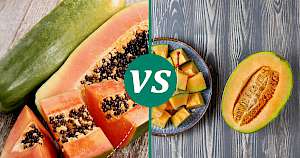Cantaloupe vs Papaya: Nutrition & Calories Compare


Cantaloupe vs Papaya
Nutrition Facts
Serving size:
change
5g10g15g20g30g40g50g60g80g100g120g140g160g180g200g220g250g300g350g400g450g500g600g700g800g900g1000g
1oz2oz3oz4oz5oz6oz7oz8oz10oz12oz15oz20oz25oz30oz35oz40oz50oz
Amount Per Serving:
Serving size:
change
5g10g15g20g30g40g50g60g80g100g120g140g160g180g200g220g250g300g350g400g450g500g600g700g800g900g1000g
1oz2oz3oz4oz5oz6oz7oz8oz10oz12oz15oz20oz25oz30oz35oz40oz50oz
Amount Per Serving:
Cantaloupe vs Papaya 100g Compare
| per 100g | Cantaloupe | Papaya |
|---|---|---|
| Calories | 34 | 43 |
| Carbohydrates | 8.16 g | 8 g |
| Fat | 0.19 g | 0.26 g |
| Dietary fiber | 0.9 g | 1.7 g |
| Protein | 0.84 g | 0.47 g |
| Calcium | 9 mg | 20 mg |
| Iron | 0.21 mg | 0.25 mg |
| Magnessium | 12 mg | 21 mg |
| Potassium | 267 mg | 182 mg |
| Sodium | 16 mg | 8 mg |
| Vitaminium B1 (Thiamine) | 0.041 mg | 0.023 mg |
| Vitaminium B2 (riboflavin) | 0.019 mg | 0.027 mg |
| Vitaminium B3 (Niacin) | 0.734 mg | 0.338 mg |
| Vitaminium B6 | 0.072 mg | 0.038 mg |
| Vitaminium B9 (Folic acid) | 0.021 mg | 37 mg |
| Vitaminium C | 36.7 mg | 60.9 mg |
| Vitaminium E | 0.05 mg | 0.3 mg |
| Vitaminium K | 0.003 µg | 2.6 µg |
Delving into the World of Cantaloupe and Papaya
When it comes to selecting the perfect fruit for a refreshing summer treat or a healthy snack, cantaloupe and papaya often top the list. Both fruits are celebrated for their unique flavors, nutritional benefits, and versatility in culinary uses. But beyond their sweet taste and health perks, these fruits have fascinating backgrounds and characteristics that might surprise you.
Did You Know?
Cantaloupe, also known as muskmelon, is part of the Cucurbitaceae family, which includes other melons and squashes. It is believed to have originated in Persia (modern-day Iran) and Africa. Cantaloupes are known for their lush orange flesh and sweet, musky aroma, which is where the name "muskmelon" comes from.
Papaya, on the other hand, is native to the tropics of the Americas and was first cultivated in Mexico. Papayas are not only enjoyed for their sweet, tropical flavor but also for their digestive enzyme, papain, which helps break down proteins and is used in meat tenderizing.
A Closer Look at Their Nutritional Profiles
When it comes to nutrition, both cantaloupe and papaya pack a punch in terms of vitamins, minerals, and other beneficial compounds. Cantaloupes are particularly noted for their high water content at 90.15%, making them incredibly hydrating. They also shine in their vitamin A and C content, essential for immune function and skin health.
Papayas are not far behind, with a notable vitamin C content that surpasses that of cantaloupes. They are also a good source of vitamin A and boast a higher fiber content, which is beneficial for digestive health. Additionally, papayas contain more magnesium, potassium, and calcium than cantaloupes, minerals that play crucial roles in maintaining heart health and bone strength.
Taste and Texture: A Sensory Experience
The taste and texture of cantaloupe and papaya can vary significantly, offering a diverse sensory experience. Cantaloupe has a sweet and slightly floral flavor, with a firm yet juicy texture that makes it a refreshing choice for hot summer days. Its versatility allows it to be enjoyed on its own, in salads, or as a sweet addition to savory dishes.
Papaya, with its tropical sweetness, has a softer, butter-like texture that melts in the mouth. Its unique flavor pairs well with acidic and spicy notes, making it a popular ingredient in salsas, salads, and smoothies. Papaya's natural tenderness also makes it an excellent tenderizer for meats.
Health Benefits Beyond Nutrition
The benefits of cantaloupe and papaya extend beyond their nutritional value. The high water content in cantaloupe promotes hydration and aids in skin health, while its antioxidants can help protect against certain diseases. Papaya's enzyme, papain, not only aids digestion but also has anti-inflammatory properties, contributing to a reduction in inflammation and pain for certain conditions.
Conclusion
Choosing between cantaloupe and papaya might come down to personal taste preferences or specific nutritional needs. Whether you're looking for a fruit that hydrates, aids in digestion, or provides a wealth of vitamins and minerals, both cantaloupe and papaya are excellent choices. Their unique flavors and textures can enhance a variety of dishes, making them a versatile addition to any meal. Next time you're at the market, consider grabbing a cantaloupe or papaya (or both!) to enjoy the myriad of health benefits and delicious flavors they have to offer.
Cantaloupe 100g
34kcalCalories source
- 87% CARBS.
- 9% PROTEIN
- 5% FAT
Papaya 100g
43kcalCalories source
- 88% CARBS
- 5% PROTEIN
- 6% FAT
Compares of cantaloupe
- Cantaloupe vs Honeydew Melon
- Cantaloupe vs Melon
- Cantaloupe vs Watermelon
- Cantaloupe vs Banana
- Cantaloupe vs Pineapple
- Cantaloupe vs Pumpkin
- see all compares of cantaloupe
Compares of papaya
Read also:
- Calories from Cantaloupe
- Calories of Fried green tomatoes
- Calories in Grilled mahi mahi
- Boiled beets calories per 100g
- Frozen garlic bread protein per 100g
- How many calories does instant soup have?
- Calories in a half of corn tortilla
- Calories in whole corn tortilla
- Calories for one, two or more corn tortillas
- How much protein in tofu?
Marcin Piotrowicz
calories-info.com creator
Healthy diet and healthy lifestyle promoter
Add comment